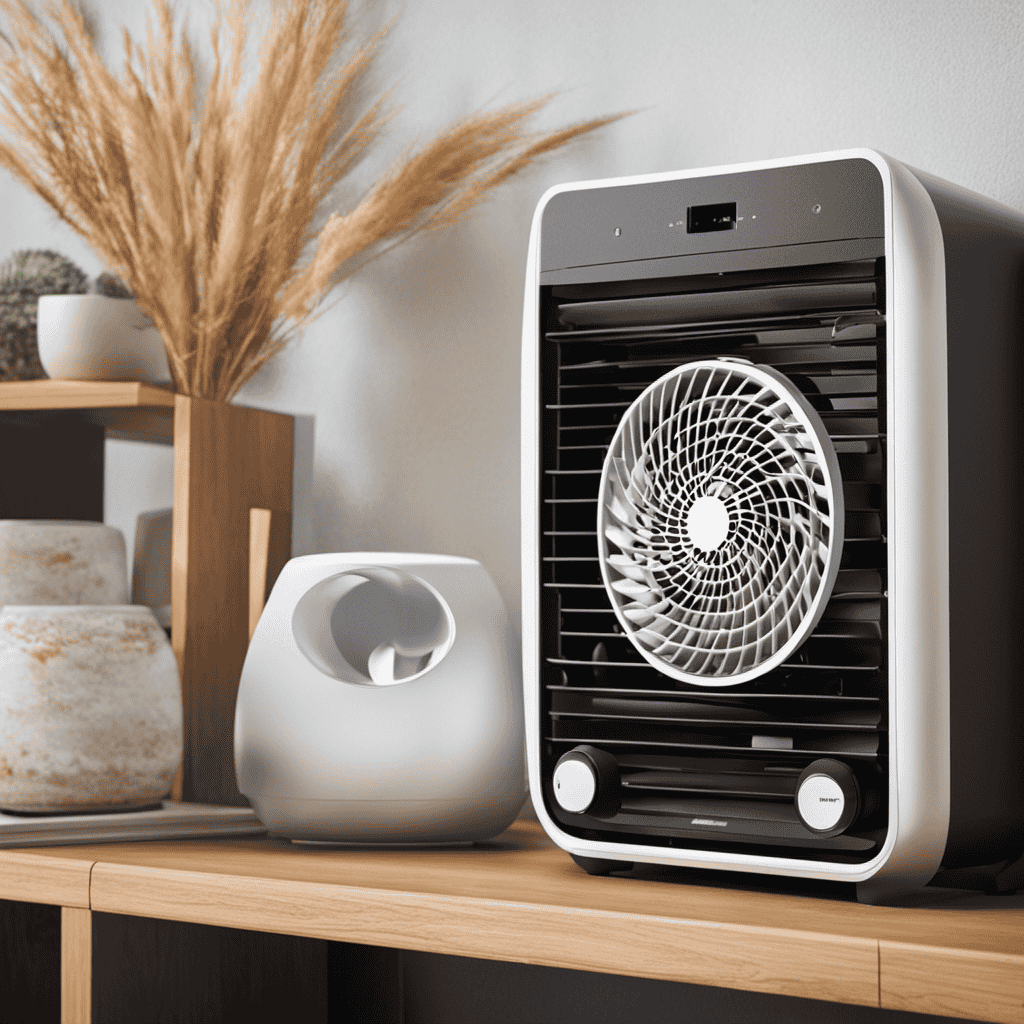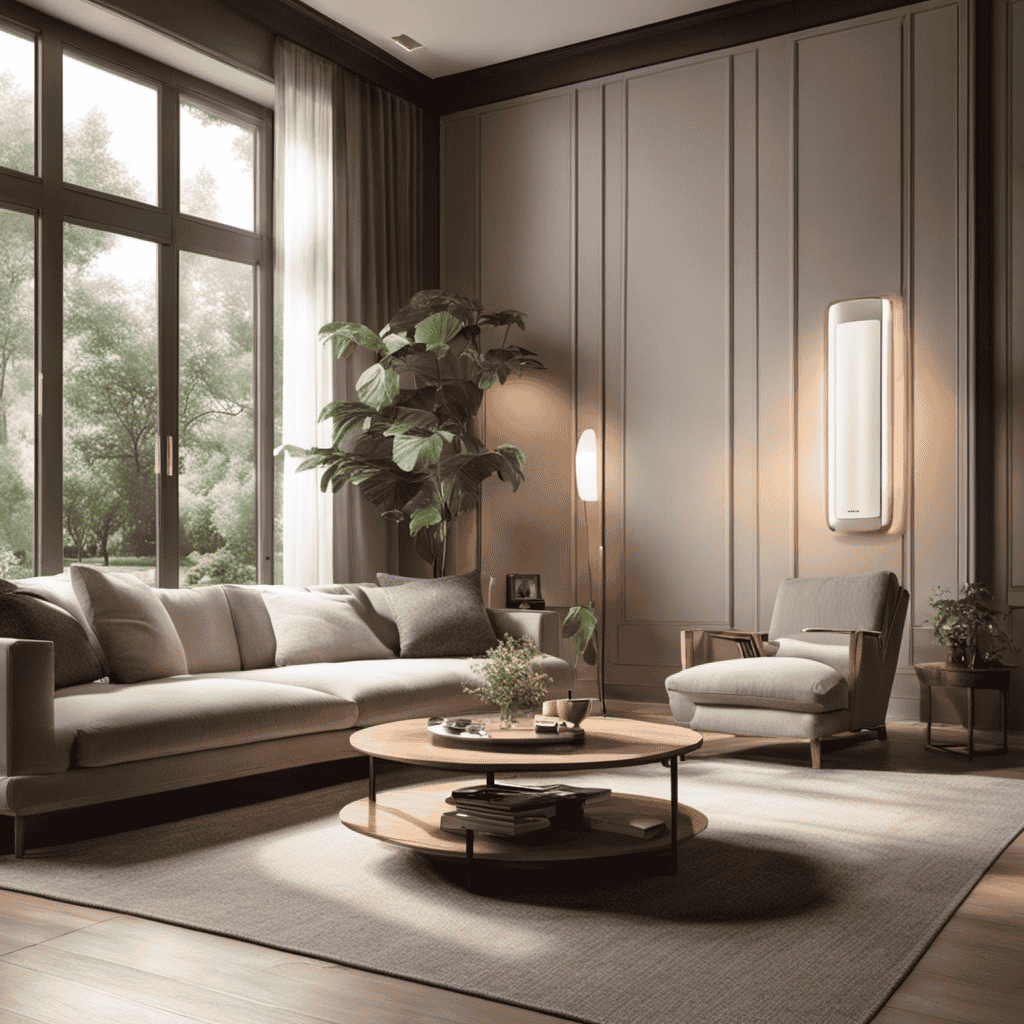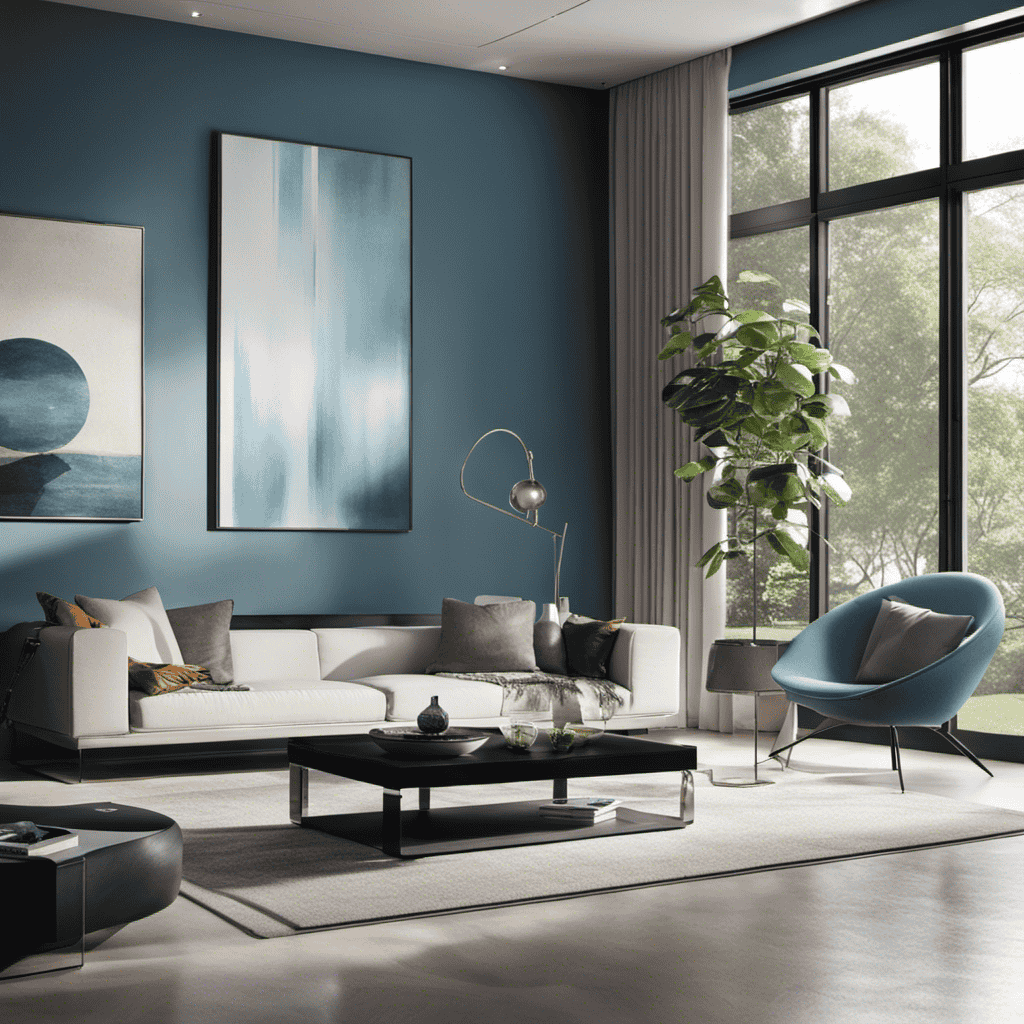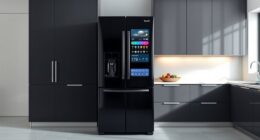Feeling overwhelmed by the pollutants and allergens in your home? Don’t worry, I have the perfect solution for you.
In this article, I’m going to show you how to make your very own air purifier. Yep, you heard me right. With just a few materials and a little bit of know-how, you’ll be well on your way to breathing in clean, fresh air in no time.
Trust me, once you experience the difference, you’ll wonder why you didn’t make one sooner.
Let’s get started, shall we?
Key Takeaways
- Gather all necessary materials and tools for making the air purifier.
- Understand the basics of air purification and the different filtration methods.
- Choose the right filter material based on air quality concerns and efficiency levels.
- Follow the proper steps for assembling the air purifier frame, installing the fan, motor, and power supply, and adding and maintaining the filter.
Gathering the Necessary Materials
Before you start, make sure you have all the necessary materials for making the air purifier.
Air purifier maintenance is crucial for ensuring optimal performance and longevity of the device. To troubleshoot air purifier performance issues, you will need a few basic tools and supplies.
Firstly, gather a screwdriver set to disassemble the unit for cleaning or repair. Additionally, have a soft cloth or brush for wiping away dust and debris that may accumulate on the filters and vents.
It is also important to have replacement filters on hand for regular maintenance. Finally, consider having an air quality monitor to assess the effectiveness of your air purifier.
Understanding the Basics of Air Purification
Now that we understand the basics of air purification, let’s dive into how it actually works. Air purification involves the use of various techniques to remove pollutants and contaminants from the air, improving its quality and making it safer to breathe. There are different air filtration techniques that are commonly used, including mechanical filtration, activated carbon filtration, and UV germicidal irradiation.
Mechanical filtration involves passing the air through filters that trap particles and pollutants. Activated carbon filtration uses activated carbon to adsorb chemicals and odors from the air. UV germicidal irradiation utilizes ultraviolet light to destroy bacteria, viruses, and other microorganisms in the air.
The benefits of air purification are numerous. It helps to reduce indoor air pollution, which can have negative effects on our health. By removing allergens, such as dust mites and pollen, air purification can alleviate symptoms of allergies and asthma. It also helps to eliminate unpleasant odors and creates a fresh and clean indoor environment. Overall, air purification plays a vital role in improving the quality of the air we breathe and promoting better health and well-being.
| Air Filtration Techniques | Benefits of Air Purification |
|---|---|
| Mechanical Filtration | Reduces indoor air pollution |
| Activated Carbon Filtration | Alleviates allergies and asthma symptoms |
| UV Germicidal Irradiation | Eliminates unpleasant odors |
Choosing the Right Filter for Your Air Purifier
When it comes to choosing the right filter for your air purifier, there are two key points to consider: filter material options and filter efficiency levels.
The filter material options include different types of materials such as HEPA, activated carbon, and electrostatic filters, each with their own unique properties and benefits.
Additionally, filter efficiency levels play a crucial role in determining how effectively the filter can remove pollutants and allergens from the air, with higher efficiency levels indicating better filtration performance.
Filter Material Options
You can choose from various filter material options for your air purifier. When it comes to air purifier maintenance, the filter plays a crucial role in trapping and removing pollutants from the air.
DIY air purifier design options allow you to customize your filter based on your specific needs. One popular filter material is activated carbon, which effectively absorbs odors, chemicals, and gases. Another option is a HEPA (High-Efficiency Particulate Air) filter, which is highly efficient in capturing small particles like dust, pollen, and pet dander. Additionally, electrostatic filters use an electric charge to attract and trap airborne particles. Some filters even combine multiple materials to provide comprehensive air purification.
It’s important to consider your specific air quality concerns and choose the filter material that best suits your needs.
Filter Efficiency Levels
To ensure optimal air quality, it’s essential to consider the efficiency levels of different filter materials. When comparing different filter efficiency ratings, it’s important to understand the factors that affect the effectiveness of air purifier filters.
One key factor is the size of the particles the filter can capture. Filters with higher efficiency ratings are capable of capturing smaller particles, such as allergens and pollutants, providing cleaner air.
Another factor is the airflow resistance of the filter. While higher efficiency filters may capture more particles, they can also restrict airflow, reducing the overall effectiveness of the air purifier. It’s crucial to strike a balance between filter efficiency and airflow resistance to ensure that the air purifier performs optimally.
Additionally, factors such as filter maintenance, filter lifespan, and the presence of additional filtration technologies should also be considered when choosing a filter material.
Assembling the Air Purifier Frame
When it comes to assembling the frame for your air purifier, there are a few important steps to follow.
First, gather all the required tools and materials, such as screws, a screwdriver, and the frame pieces themselves.
Next, carefully follow the assembly steps provided in the instruction manual, making sure to secure each piece tightly for a sturdy frame.
Frame Assembly Steps
The next step in the frame assembly process is to attach the front and back panels together. This is a crucial step in ensuring the stability and durability of the air purifier.
To achieve efficient assembly, there are a few tips to keep in mind. Firstly, make sure to align the panels properly before tightening the screws. This will prevent any misalignment and ensure a secure fit.
Secondly, use a power drill or screwdriver to save time and effort. It is also important to avoid common mistakes that can compromise the assembly. Avoid over-tightening the screws, as this can damage the panels or strip the threads.
Additionally, double-check that all screws are tightened evenly to maintain a balanced frame. With these tips in mind, let’s move on to the next section where we will discuss the required tools and materials for the frame assembly.
Required Tools and Materials
You’ll need a power drill or screwdriver for efficient assembly of the frame. When it comes to making an air purifier, choosing the right fan for air purification is crucial. The fan is responsible for drawing in air and pushing it through the filtration system. It’s important to select a fan that has enough power to effectively circulate the air in your space. Additionally, proper air circulation is essential for effective air purification. Without proper circulation, pollutants and allergens can linger in the air, reducing the overall effectiveness of the purifier. To ensure optimal performance, consider the size of your space and choose a fan that can adequately circulate the air in that area. Don’t underestimate the importance of a properly chosen fan and the impact it can have on the air quality in your home.
| Column 1 | Column 2 | Column 3 |
|---|---|---|
| Keyword | Description | Importance |
| Fan | Draws in air | Crucial |
| Filtration | Cleans air | Essential |
| Circulation | Moves air | Vital |
| Air quality | Improves | Significant |
Tips for Secure Assembly
Properly securing the frame during assembly is crucial for efficient performance.
When assembling your air purifier, it’s important to ensure that all parts are securely fastened together. This not only ensures the stability of the unit but also helps in maintaining its effectiveness in purifying the air.
To achieve secure fastening, make sure to follow the manufacturer’s instructions carefully. Use the provided screws, bolts, or clips to firmly attach the frame components together. It’s also advisable to periodically check the tightness of the fastenings to prevent any loosening over time.
Additionally, don’t forget to take necessary safety precautions during assembly. Wear protective gloves if required and avoid putting excessive force or pressure on any fragile parts.
Installing the Fan and Motor
First, make sure to securely attach the fan and motor to the frame of the air purifier. This is crucial for proper functioning and efficiency.
Begin by placing the fan in a central location within the purifier’s frame. Ensure it is aligned properly and firmly attached using screws or brackets.
Next, locate the motor and position it adjacent to the fan. Connect the motor to the fan using a compatible coupling mechanism. This will allow the motor’s rotational energy to be transferred to the fan blades, creating airflow.
To control the speed of the motor, consider incorporating a speed control module or switch. This will enable you to adjust the fan’s speed according to your preferences.
Connecting the Power Supply
Now that the fan and motor are installed, the next step is to connect the power supply. This is a crucial step in ensuring that the air purifier functions properly. Proper electrical wiring is essential for safety and efficient operation.
To connect the power supply, follow these steps:
| Step | Description |
|---|---|
| 1 | Turn off the power source. |
| 2 | Strip the insulation from the ends of the power cord wires. |
| 3 | Connect the positive (red) wire from the power cord to the positive terminal on the fan motor. |
| 4 | Connect the negative (black) wire from the power cord to the negative terminal on the fan motor. |
| 5 | Secure the connections with electrical tape or wire nuts. |
| 6 | Plug in the power cord and turn on the power source. |
Adding the Filter to the Air Purifier
To add the filter, you’ll need to locate the filter compartment and carefully insert the filter in the designated slot. Most air purifiers come with a standard filter, but there are alternative filter options available in the market. These alternative filters cater to specific needs such as removing pet dander or eliminating odors.
When adding the filter, make sure to follow the manufacturer’s instructions to ensure proper installation. If you encounter any issues with the filter, there are common troubleshooting steps you can take. Firstly, check if the filter is inserted correctly and securely.
If the air purifier is not functioning properly, it could be due to a clogged filter. In such cases, cleaning or replacing the filter may be necessary to restore optimal performance.
Testing and Adjusting the Air Purifier Performance
Once you’ve added the filter, you can test and adjust the performance of the air purifier. Testing the air purifier is crucial to ensure that it is effectively removing pollutants from the air.
Here are three testing methods that can help you evaluate the performance of your air purifier:
-
Particle Counting: Using a particle counter, measure the number of particles in the air before and after running the purifier. A significant reduction indicates effective filtration.
-
Odor Elimination: Introduce a strong odor into the room and observe how well the purifier removes it. A noticeable reduction in odor indicates good performance.
-
Allergen Reduction: If you suffer from allergies, expose the air purifier to allergens like pollen or pet dander and assess how well it eliminates them from the air.
Maintaining and Cleaning Your DIY Air Purifier
Regular maintenance is essential for keeping your DIY air purifier running efficiently and ensuring that it continues to provide clean and healthy air.
To maintain your air purifier, there are a few cleaning techniques you should follow. First, regularly clean or replace the air filters to prevent them from becoming clogged with dust and debris.
Additionally, wipe down the exterior of the purifier with a damp cloth to remove any surface dirt or dust.
Troubleshooting common issues with your DIY air purifier is also important. If you notice a decrease in air flow or a strange odor, check the filters and clean or replace them if necessary. It’s also crucial to inspect the fan and motor for any signs of damage or malfunction.
Frequently Asked Questions
How Long Does It Typically Take to Assemble an Air Purifier?
Typically, it takes around 30-60 minutes to assemble an air purifier. The necessary components include a fan, a filter, a housing unit, and some basic tools.
Can I Use Any Type of Fan and Motor for My DIY Air Purifier?
Yes, you can use any type of fan and motor for your DIY air purifier. However, it’s important to consider fan selection and motor compatibility to ensure optimal performance and efficiency.
Is It Possible to Make a Portable Air Purifier?
Making a portable air purifier at home is possible, but there are pros and cons compared to commercially available ones. It can be cost-effective, but may not have the same level of efficiency or features.
Are There Any Safety Precautions I Should Be Aware of When Connecting the Power Supply?
When connecting the power supply for your air purifier, it’s important to be aware of safety precautions. Ensure proper electrical connections and follow manufacturer guidelines to prevent any potential hazards or accidents.
How Often Should I Replace the Filter in My DIY Air Purifier?
I replace the filter in my DIY air purifier every 3-6 months. To clean it, I gently vacuum or rinse it with water and let it dry completely before reassembling. The best materials for a DIY air purifier filter are activated carbon and HEPA filters.
Conclusion
In conclusion, creating your own air purifier can be a rewarding and cost-effective project. By following the steps outlined in this article, you can gather the necessary materials and assemble a functional air purifier.
Remember to choose the right filter for your specific needs and regularly clean and maintain your DIY creation to ensure optimal performance.
With a little know-how and some handy tools, you can breathe easier and enjoy cleaner air in your home. So go ahead and give it a whirl, and start purifying your air today!










